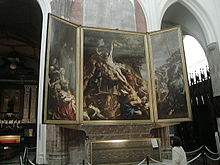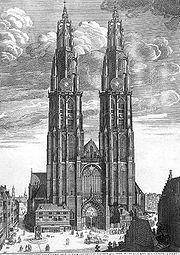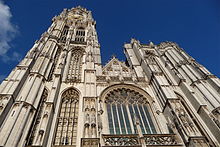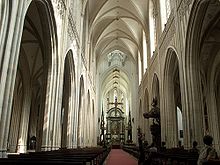- Cathedral of Our Lady (Antwerp)
-
For other uses, see Church of Our Lady (disambiguation).
Cathedral of Our Lady 
Cathedral of Our Lady
Basic information Location Antwerp Geographic coordinates 51°13′14″N 4°24′02″E / 51.22056°N 4.40056°ECoordinates: 51°13′14″N 4°24′02″E / 51.22056°N 4.40056°E Affiliation Roman Catholic Region Diocese of Antwerp Year consecrated 1521 Ecclesiastical or organizational status Cathedral Leadership Johan Bonny Website De Kathedraal Architectural description Architect(s) Jan and Pieter Appelmans Architectural type Cathedral Architectural style Gothic Direction of façade W Groundbreaking 1352[1] Completed 1521 Specifications Capacity 25000 Length 120 metres (390 ft) Width 75 metres (246 ft) Width (nave) 53.5 metres (176 ft) Height (max) 123 metres (404 ft) UNESCO World Heritage Site Official name: Belfries of Belgium and France Criteria: ii, iv Designated: 1999[2] Reference #: 943 Type: Cultural State Party:  Belgium and
Belgium and  France
FranceRegion: Europe and North America
The Cathedral of Our Lady (Dutch: Onze-Lieve-Vrouwekathedraal) is a Roman Catholic cathedral in Antwerp, Belgium. Today's see of the Diocese of Antwerp was started in 1352 and, although the first stage of construction was ended in 1521, has never been 'completed'. In Gothic style, its architects were Jan and Pieter Appelmans. It contains a number of significant works by the Baroque painter Peter Paul Rubens, as well as paintings by artists such as Otto van Veen, Jacob de Backer and Marten de Vos.The cathedral is on the list of World Heritage Sites.[3]
Contents
History
Where the cathedral now stands, there was a small chapel of Our Lady from the 9th to the 12th century, which acquired the status of parish church in 1124.[1] During the course of the twelfth century, it was replaced by a larger Romanesque church (80 metres (260 ft) long and 42 metres (138 ft) wide).[1]
In 1352, construction was begun on a new Our Lady’s church which would become the largest Gothic church in the Netherlands. In the beginning, it was to be provided with two towers of equal height. In 1521, after nearly 170 years, the new church of Our Lady was ready. The south tower reached only as far as the third string course.
During the night of 5–6 October 1533, the new church was largely gutted by fire. The completion of the second tower was therefore delayed, which led to its ultimate postponement. Moreover, the church only became cathedral of the bishopric of Antwerp in 1559 but lost this title again from 1801 to 1961, following the Concordat of 1801.[1][4] During the Iconoclasm of 20 August 1566 (at the start of the Eighty Years' War), Protestants destroyed a large part of the cathedral interior. Later, when Antwerp came under Protestant administration in 1581, a number of artistic treasures were once again destroyed, removed or sold. The restoration of Roman Catholic authority came in 1585 with the fall of Antwerp.
In 1794 the French revolutionaries that conquered the region plundered Our Lady’s Cathedral and inflicted serious damage.[1] Around 1798, the French administration intended to demolish the building but after each blow, the cathedral was able to recover. In 1816, various important works of art were returned from Paris, including three Rubens masterpieces. And over the course of the 19th century, the church was completely restored and refurnished.
Between 1965 and 1993, a complete restoration took place.[1]
Musical life
At the beginning of the 15th century, the cathedral's choir started developing an active musical life, and as a result, the cathedral's importance in the history of music soon soared. Johannes Ockeghem, one of the most important composers of the 15th century, served here as a vicar-singer in 1443, and so did Jacob Obrecht between 1492 and 1497. Organists who worked at the cathedral include Henry Bredemers (1493–1501), who went on to become a teacher to Philip the Handsome's children, and the renowned English composer John Bull (1615–1628), who fled to Flanders from his home country escaping justice. From 1725 to 1731 Willem de Fesch served as Kapelmeester followed from 1731 to 1737 by Joseph-Hector Fiocco. Lesser known, but locally important figures, such as Jacobus Barbireau and Andreas Pevernage, also worked at the cathedral.
Significant architectural details
The church's one finished spire is 123 metres (404 ft) high, the highest church tower in the Benelux. Charles V, Holy Roman Emperor commented that the spire should be kept under glass, and Napoleon compared the spire to Mechlin lace.[5] The largest bell in the tower requires 16 bell ringers.[6]
The west portal features statues which include the missionary Saint Willibrordus. He is thought to have spent time in Antwerp in the 7th century.
Major works of art
 Peter Paul Rubens, The Raising of the Cross
Peter Paul Rubens, The Raising of the Cross
Two of these artworks were taken from the cathedral to France by Napoleon, The Raising of the Cross and The Descent from the Cross, but were returned to the cathedral in the 19th century.[5]
- The Raising of the Cross – Peter Paul Rubens
- Assumption of the Virgin Mary – Peter Paul Rubens
- The Descent from the Cross – Peter Paul Rubens
Burials
- Hubert Waelrant
- Maol Muire Ó hÚigínn, Archbishop of Tuam in Ireland (1586–1590) – died in Antwerp on his return to Ireland from Rome
Facts and figures
- Interior length: 118 metres (387 ft)[1]
- North tower height:123 metres (404 ft)[1]
- South tower height: 65.3 metres (214 ft)[1]
- Central aisle height: 28 metres (92 ft)[1]
- Lantern height or crossing-tower where the nave and transepts meet: 43 metres (141 ft)[1]
- Maximum width of the nave: 53.5 metres (176 ft)[1]
- Total surface area of the floor: 8,000 square metres (86,000 sq ft)[1]
- Surface area of the roof: more than 10,000 square metres (110,000 sq ft)[1]
- Capacity: 2,400 seats . In principle, the Cathedral can hold 25,000 people[1]
- The Cathedral has 7 bays, 125 columns and 128 windows (of which 55 are stained-glass)[1]
- 57 permanent altars distributed throughout the Cathedral[1]
- The nineteenth-century Schyven organ has 90 registers and 5,770 pipes[1]
- The Cathedral has a carillon with 49 bells[1]
- The heaviest bell is the Karolus (1507) weighs 6,434 kilograms (14,180 lb)[1]
- Maintenance of the Cathedral costs 1.5 million euros per year[1]
Notes
- ^ a b c d e f g h i j k l m n o p q r s t u "History". Diocese of Antwerpen. http://www.dekathedraal.be/en/geschiedenis.htm. Retrieved 2009-01-03.
- ^ "Unesco, Works of Antoni Gaudí". Whc.unesco.org. http://whc.unesco.org/en/list/943. Retrieved 2011-02-03.
- ^ Wikipedia article on Belfries of Belgium and France
- ^ The bishopric of Antwerp was abolished during this period
- ^ a b Dunton, Larkin (1896). The World and Its People. Silver, Burdett. p. 164.
- ^ Dunton, Larkin (1896). The World and Its People. Silver, Burdett. p. 165.
References
- Rynck, Patrick (2005). The Cathedral of Our Lady in Antwerp. Ghent: Ludion. ISBN 9055445800.
External links
- De Kathedraal – official website
- Cathedral of Our Lady, Visit Antwerpen
- Antwerp Cathedral at Sacred Destinations
- Organs in the Antwerp Cathedral
- Towers of the Cathedral
Tallest buildings and structures in Belgium 
Skyscrapers South Tower · Finance Tower · Dexia Tower · Madou Plaza Tower · Astro Tower · North Galaxy Towers · World Trade Center · Belgacom Towers · KBC TowerRadio and TV towers VRT Zendstation Egem · Sint-Pieters-Leeuw Tower · Zendmast Ruiselede (destroyed) · Wavre Transmitter · Mechelen-Zuid Telecommunications and Water TowerOther Cathedral of Our Lady, Antwerp · Church of Our Lady, Bruges · Brussels Justice Palace · Atomium · Saint Martin's Cathedral, Ypres · Saint Vincent Church · St. Rumbold's Cathedral · Brussels Town Hall · Pont de WandreCategories:- Roman Catholic cathedrals in Belgium
- 1351 establishments
- Religious buildings completed in 1521
- Churches in Antwerp
- Gothic architecture in Belgium
Wikimedia Foundation. 2010.



